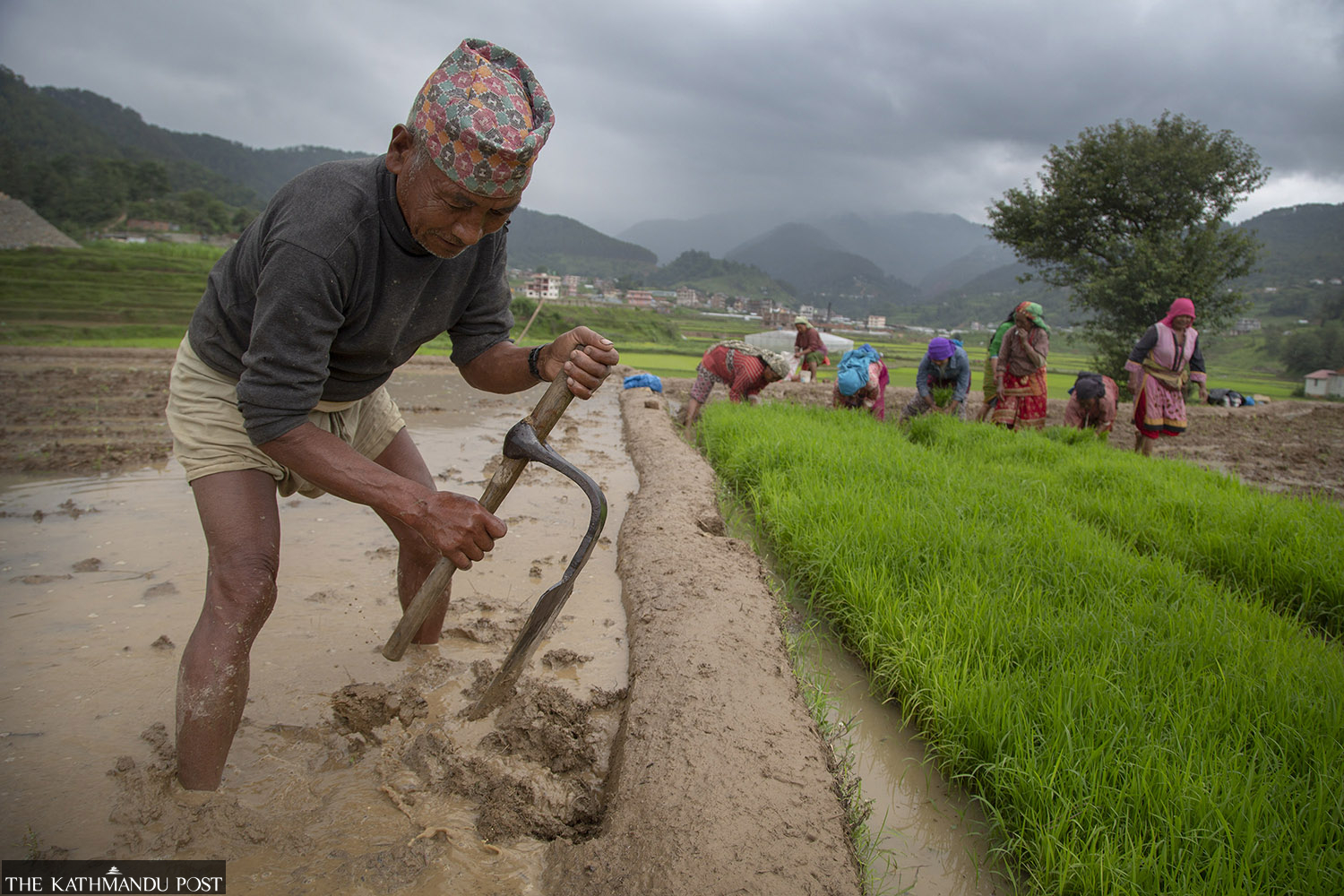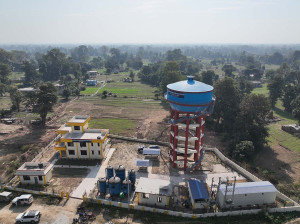Money
Crippling fertiliser shortage clouds Paddy Day celebrations for thousands of farmers
If farmers can't get chemical fertilisers on time due to government bungling, they face reduced harvests and incomes.
Sangam Prasain
Nepali farmers will likely be celebrating the National Paddy Day on Wednesday with a glum face because the government appears none too concerned about ensuring adequate supply of chemical fertiliser for the year's most important crop.
Doubts about being able to get the plant nutrients during the crucial season have dampened the mood for tens of thousands of farmers across the country, and they don't feel much like rejoicing during the annual festival marking the start of the paddy transplanting season, insiders say.
If the farmers can't get chemical fertiliser on time because of government bungling, they face reduced harvests and slashed incomes, which could cause a food shortage and fuel inflation.
The country’s economy is already struggling with a slow growth rate, high inflation and low employment which experts say is a sign of stagflation. The loss in production would add further woes to the ailing economy, economists have warned.
The government is making efforts to procure fertiliser through a government-to-government deal with India after state-run companies failed to make timely imports mainly due to high costs.
According to officials, fertiliser prices have swelled four to five-fold within a year, and the government would need more than Rs70 billion for subsidies to fulfil the farmers' demands.
The government had set aside Rs15 billion to import chemical fertiliser. But at current prices, the money will be barely enough to buy 200,000 tonnes, said an official at the Salt Trading Corporation, one of the two state-run supplying agencies.
The government-to-government deal, signed in February, was expected to avoid long hassles to import products, but it seems to have run into one legal hurdle after another.
Chances of early availability of chemical fertiliser seem bleak, said an official at the Agriculture Ministry.
The cabinet had recently cleared a bunch of legal hurdles to facilitate a rush shipment of urgently needed crop nutrients, allowing the Agriculture Inputs Company to make a full advance payment to the Indian supplier designated by New Delhi. But many legal problems still remain.
“India has asked us to take delivery of bulk shipments of chemical fertiliser, and this has made things complicated,” said Prakash Kumar Sanjel, spokesperson for the Agriculture Ministry.
“Bulk shipping means the fertiliser will be loaded onto containers directly without packaging. But our law doesn't allow us to bring the product without packaging. Even if the product is brought to the border checkpoints, it needs to be properly packaged. So we will need to make another call for tenders,” he said. “This obviously means a lot more time to bring fertiliser.”

According to Sanjel, the ministry had last Wednesday dispatched a letter to New Delhi through the Foreign Ministry with a request for packaged fertiliser.
Nepal had signed a memorandum of understanding with India for the supply of 150,000 tonnes of chemical fertiliser through a government-to-government deal, but the southern neighbour had promised to send a shipment of 50,000 tonnes of urea and 30,000 tonnes of DAP by mid-July as a crisis mitigating measure.
Experts say that for the first time ever, farmers across the world are facing a shortage of chemical fertiliser—all at the same time.
Agriculture is the mainstay of Nepal's economy, employing around 60 percent of the total workforce and contributing 25 percent to the national economy.
The Ministry of Agriculture and Livestock Development has estimated that the annual demand for fertiliser stands at around 600,000 tonnes.
Dhiraj Yadav of Khajani, Rupandehi has transplanted paddy on his 7-bigaha farm (4.69 hectares) without using fertiliser.
“It is not certain when fertiliser will be available. We can't miss the date to transplant paddy. I did it without chemical fertiliser,” Yadav said. He immediately needs 20 sacks of fertiliser but has not got even a grain of it.
Yadav is encouraged by the abundant rainfall, but he fears a poor harvest.
In Jwalamukhi Rural Municipality, Dhading, paddy farmer Hari Thapa was forced to buy a sack of smuggled chemical fertiliser for Rs2,100.
"The price depends on the size of the grain of the fertiliser. Small grain costs Rs2,100 and large grain costs Rs2,600 per sack.”
As the government has not been able to supply subsidised fertiliser, smuggling has thrived. Experts say contraband fertiliser is of doubtful quality and substandard products may damage the crop.
“Farmers are compelled to pay the price fixed by traders for the smuggled inputs,” said Thapa.
Another farmer Raj Kumar Shrestha said that for farmers, fertiliser was more important than money. “The market is flooded with smuggled fertiliser, but at least it is available,” Shrestha said. “Usually, a sack of fertiliser would cost Rs900, but we are buying it for Rs2,800 per sack.”
Earlier this month, Agriculture Minister Mahendra Ray Yadav was in New Delhi to follow up on fertiliser procurement from India.
Parliament has also directed the government to ensure adequate supply of chemical fertilisers to farmers.
Officials from the Agriculture Inputs Company, the agency which has been mandated to supply 70 percent of the subsidised chemical fertiliser, have been making frequent trips to New Delhi and Mumbai to sign a commercial agreement with the Rashtriya Chemicals and Fertilisers, the company which New Delhi has designated to supply chemical fertiliser to Nepal.
“The officials are currently in India waiting to sign the commercial agreement,” said spokesperson Sanjel. “After the commercial agreement is signed, we have to place an order within two working days, and release the full payment in another two working days.”

Meanwhile, Rajendra Bahadur Karki, general manager of the Agriculture Inputs Company, told the Post correspondent in New Delhi that the Rashtriya Chemicals and Fertilisers has agreed to dispatch 15,000 tonnes of urea in the first lot.
Karki is currently in Mumbai to sign a commercial agreement.
“The consignment will be dispatched from the Dhamra Port in Odisha, India,” Karki said. “The Indian side will package the fertiliser with Agriculture Inputs Company’s name in the sacks and the products will be delivered to Birgunj by the Indian side.”
The commercial agreement, however, is yet to be signed, he said.
Sanjel said that Nepal had also requested India to arrange all available means of transport, train or truck, to dispatch the fertiliser. “If India provides the committed fertiliser, our transport system will not be able to handle the shipments on time.”
Nepal requires 210,000 tonnes of chemical fertilisers for the paddy planting season, and it must have 150,000-170,000 tonnes to avoid a disaster. The paddy transplantation season runs from early June to August. If the monsoon is delayed, the transplantation period extends to September.
The DAP requirement for the paddy season is 60,000 tonnes. According to Sanjel, the DAP stock is currently at 30,000 tonnes.
Around 7,000 tonnes of urea arrived on Sunday. “We expect another 25,000 tonnes of urea to be delivered within a few days.”
Urea is required for top dressing, which is done three weeks after the transplantation is completed.
“We are making a plan and are hopeful that farmers will get urea for top dressing.”
Farmers use urea because it is heavily subsidised. Urea is the most important nitrogenous fertiliser in the market, with the highest nitrogen content of 46 percent. The nitrogen boosts the growth of the plant.
In Nepal, urea is sold to farmers at the subsidised rate of Rs15 per kg.
According to reports, fertiliser prices have been climbing for more than a year for a host of reasons—runaway pricing for natural gas, the main feedstock for much of the world’s nitrogen fertiliser; sanctions on a major Belarusian potash producer; back-to-back late summer storms on the United States Gulf Coast that temporarily shut in production in the region; plus Covid-19 restrictions that have disrupted every global supply chain, including chemicals.
China, the world's largest phosphate producer, restricted outgoing shipments in order to build up a stockpile at home, further exacerbating the global shortage.
Russia’s invasion of Ukraine, which effectively cut off nearly a fifth of the world’s nutrient exports, worsened the problem.
(With inputs from our Delhi correspondent Rajesh Mishra and reporters based in districts.)




 14.12°C Kathmandu
14.12°C Kathmandu













